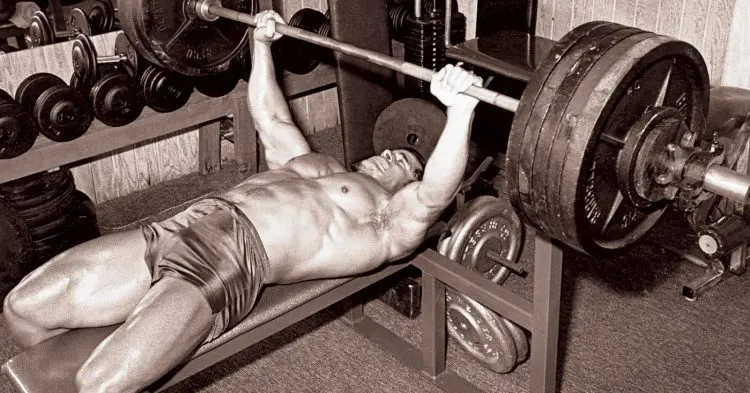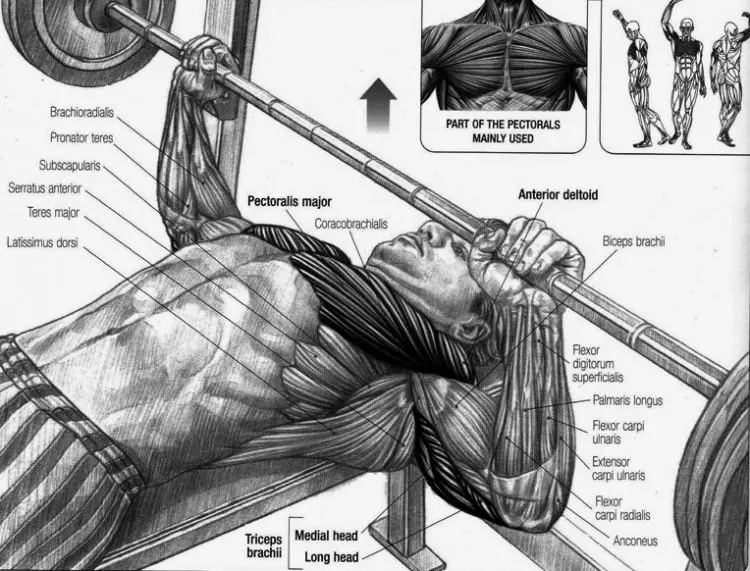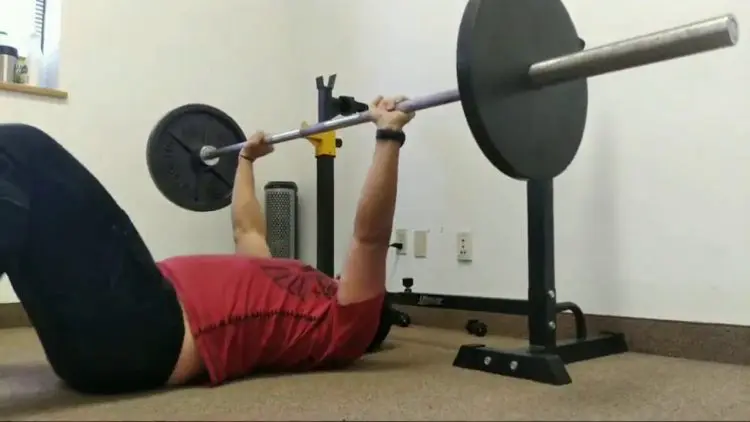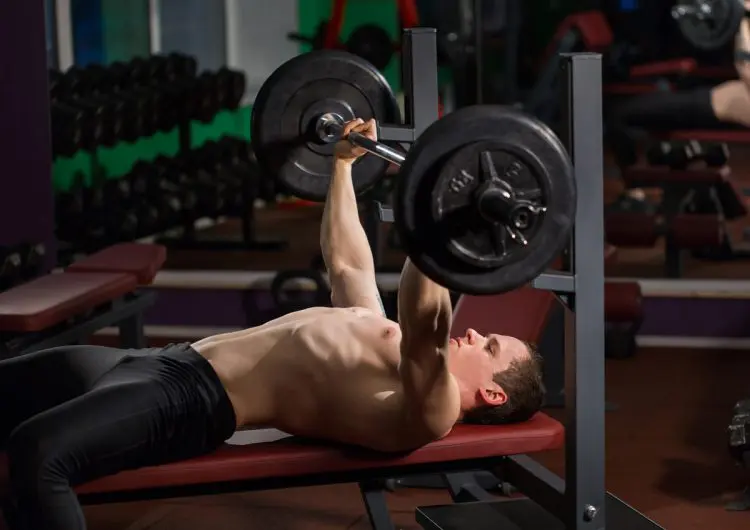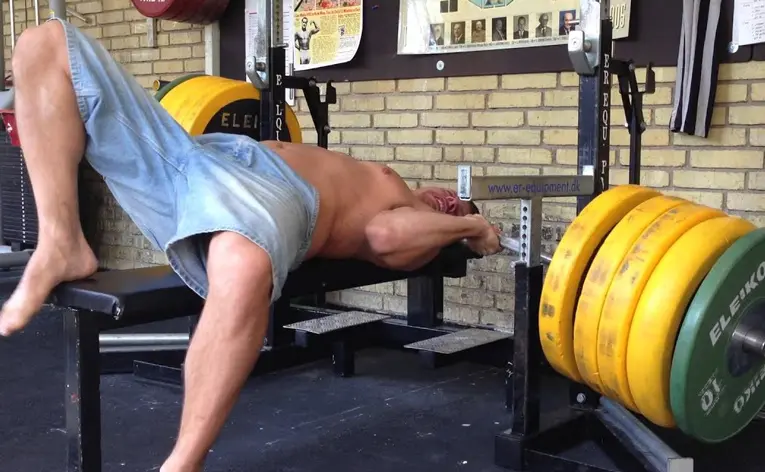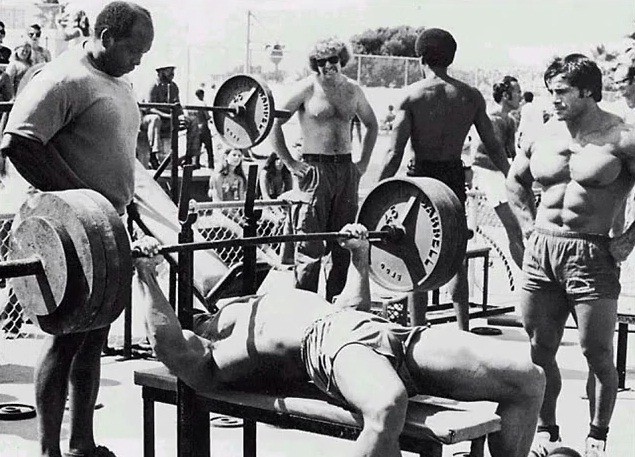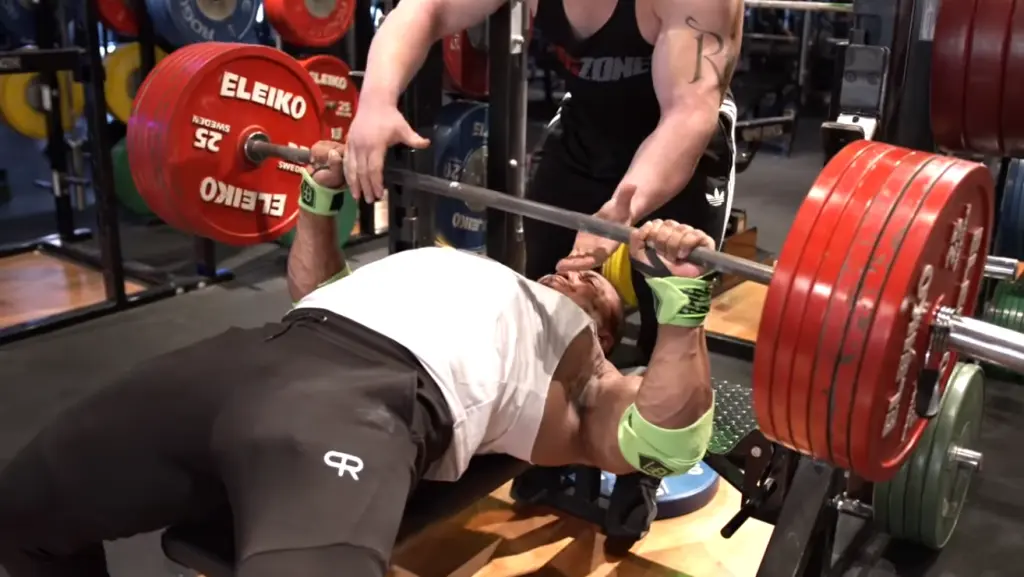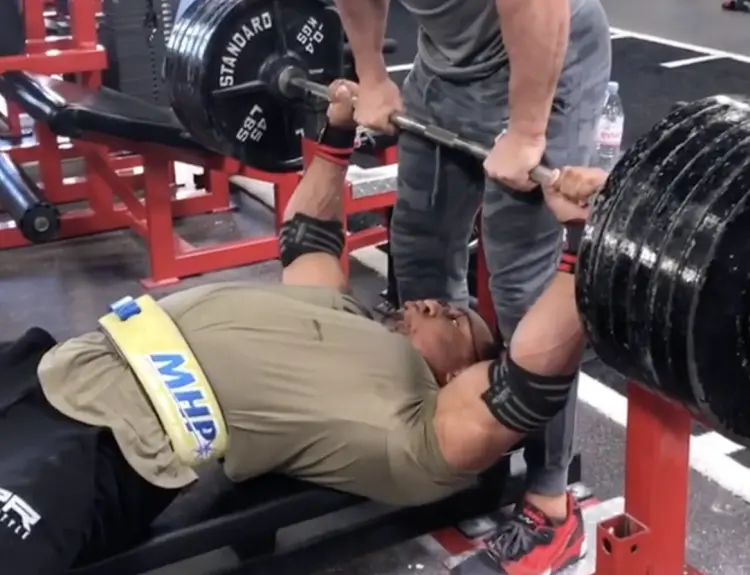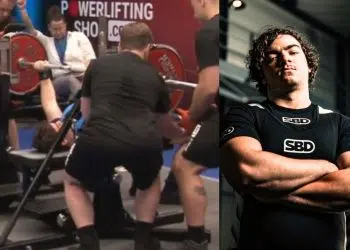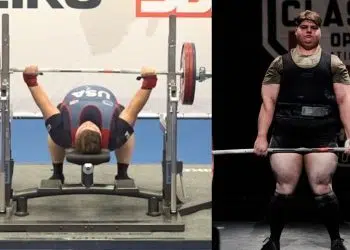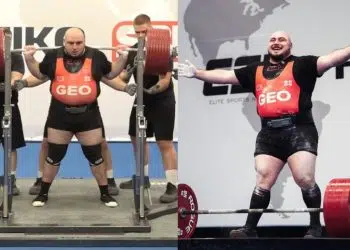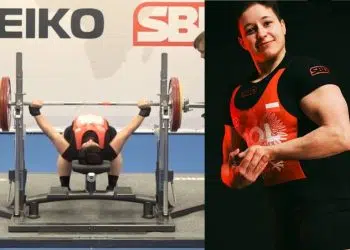Ask most bodybuilders what their favorite body part is to train, and a lot of them will tell you it’s their chest. After all, who DOESN’T love that feeling of pumped-up pecs?! Ask those same bodybuilders what their favorite chest exercise and many of them will tell you it’s the bench press.
However, as popular and clearly beneficial as the bench press is, there is another exercise that may be worth adding to your chest workout – the floor press. The floor press is not as well-known as the bench press and is often viewed as the “poor cousin” of the world’s favorite pec builder, but it’s actually a very valuable exercise.
In this article, explore the differences and similarities of these two classic upper-body exercises and reveal some variations of each one so that you can choose the right one for your goals.
Floor Press Basics
In simple terms, the floor press is a bench press performed without a bench. It predates the bench press and was how old-time strongmen and bodybuilders did prone presses before flat and adjustable training benches became common.
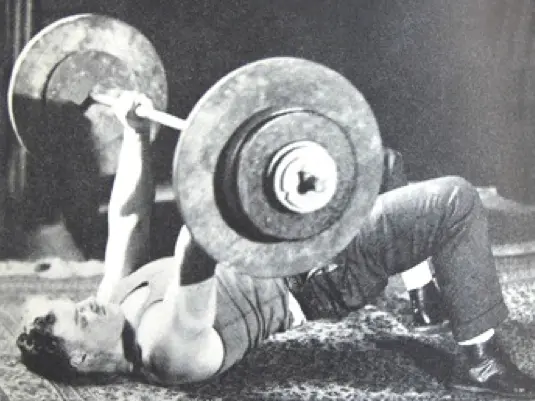
One of the earliest proponents of the floor press was strongman and wrestler George Hackenschmidt, who also invented the hack squat. In those days, the floor press was often done in a bridge position, and lifters did a sort of pull-over to get the bar into position.
Others used a “belly thrust” to get the bar up. It was these awkward maneuvers that resulted in the invention of the modern bench press.
Level Up Your Fitness: Join our 💪 strong community in Fitness Volt Newsletter. Get daily inspiration, expert-backed workouts, nutrition tips, the latest in strength sports, and the support you need to reach your goals. Subscribe for free!
How to Do the Floor Press
- Set up a squat rack so that the J-hooks are set to about knee height. Place a barbell on the hooks.
- Lie down on the floor so that your eyes are directly beneath the bar. Bend your legs and place your feet on the floor or straighten your legs as preferred.
- Grip the bar with an overhand, slightly wider than shoulder-width grip. Pull your shoulders back and down and press your upper back into the floor. This will increase shoulder stability.
- Unrack the bar and hold the weight with your arms straight. Inhale, bend your arms, and lower the bar down until the back of your upper arms lightly touch the floor.
- Without bouncing, forcefully extend your arms and push the weight back up to arms’ length. Continue until you have completed all the required reps. On completion, carefully re-rack the bar.
The floor press can also be done “from the ground up.” Using large-diameter plates, lie under the bar and adopt your preferred grip. You may need to raise the bar a little higher, e.g., on stacked weight plates, to get into the perfect starting position.
Floor Press Muscle Worked
The floor press is a compound exercise which means it involves several joints and muscles working together. The main muscles trained during floor presses are:
Pectoralis major – the large fan-shaped muscle on the front of your chest. Known as the pecs for short, the functions of this muscle are horizontal flexion, adduction, and medial rotation of the shoulder joint.
Anterior deltoid – the front of the three deltoid muscles, the anterior deltoid works alongside the pecs during flexion of the shoulder joint.
Triceps brachii – located on the back of your upper arm, and known as the triceps for short, this muscle extends your elbow.
Floor Press Variations
The barbell floor press is just one way to do this old-school exercise. Variations include:
Narrow grip floor press
Bring your hands in so they’re around shoulder-width apart. This increases triceps activation. Narrow-grip floor presses are an excellent triceps builder, and done with heavy weights will increase triceps strength too.
Dumbbell floor press
Doing floor presses with dumbbells instead of a barbell requires and develops balance and coordination. It’s a useful way to identify and fix left-to-right strength imbalances. You can also do this exercise with kettlebells.
Alternating arm dumbbell floor press
As described above but using an alternating arm action. Start with your arms bent, pressing one arm up at a time, or both arms straight, lowering the weights alternately. Both options are equally effective.
Single-arm floor press
Using just one weight increases core activation, as you’ll have to work hard to avoid rolling to one side. Also, with one arm free, you can use your other hand to help you get into the proper starting position and even spot yourself if you are unable to complete a rep. You can also do this exercise with a kettlebell.
Bridge floor press
This exercise mimics a decline bench press and also increases your range of motion. As well as working your chest, this variation provides a workout for your glutes, hamstrings, and lower back. Do it with a barbell, or dumbbells are preferred.
How to do it:
- Set up for the floor press as usual and unrack the bar.
- Push your feet into the floor and lift your hips up. Your knees, hips, and shoulders should form a straight line.
- Keep your hips up, bend your arms, and lower the bar down until your elbows lightly touch the ground. Push the bar back up and repeat.
- Keep your hips elevated throughout.
Bench Press Basics
It’s hard to think of a chest workout without bench presses, but, in reality, the bench press is a relatively new exercise and only became popular from the 1950s onwards. Before that, lifters either did all their pressing while standing (i.e., overhead presses) or worked their pecs with parallel bar dips, push-ups, and floor presses.
However, not long after being invented, the bench press soon became part of the sport of powerlifting and was also adopted by bodybuilders. The bench press is now one of the most widely recognized and commonly performed in most gyms.
How to Do the Bench Press
- Lie on your back on the bench with your eyes directly beneath the bar. Reach up and hold the bar with an overhand, slightly wider than shoulder-width grip. For most bench press variations, your forearms should be vertical at the bottom of each rep.
- Brace your abs, pull your shoulders back and down, arch your lower back slightly, lift your chest up toward the bar, and push your feet into the floor. This will help stabilize your body.
- Unrack the bar and hold it directly over your chest.
- Bend your arms and lower the bar with control until it lightly touches your sternum. As the bar descends, tuck your elbows down and slightly inward toward your sides. Do not bounce the bar off your chest. Instead, imagine you have a pane of glass on your chest and touch the bar down very lightly.
- Push your bar up, flaring your elbows as the bar nears the top of your rep. Extend your arms fully without locking your elbows.
Bench Press Muscle Worked
Like the floor press, the bench press is a compound exercise and involves all of the same muscles, i.e., pectoralis major, anterior deltoids, and triceps. The main difference is that these muscles work through a larger range of motion.
Bench Press Variations
There are many different bench press variations, and we’ve listed 15 of the best in this in-depth article. As well as incline and decline bench presses, other popular variations include:
Narrow grip bench presses
Narrow grip bench presses – done with a shoulder-width grip to increase triceps activation.
Spoto bench press
Spoto bench press – named after champion powerlifter and arm-wrestler Eric Spoto, the Spoto bench press involves pausing with the bar 3-6” above your chest instead of touching it.
Guillotine bench press
Guillotine bench press – also known as the Gironda neck press, this variation involves lowering the bar to your neck instead of your chest to increase upper chest activation.
Reverse-grip bench press
This old-school bench press variation increases upper chest and triceps activation. Some lifters also find it more shoulder-friendly.
How to do it:
- Lie on your bench with your eyes beneath the bar. Plant your feet firmly on the floor. Brace your abs. Reach up and grab the bar with an underhand, slightly wider than shoulder-width grip. Pull your shoulders down and back.
- Unrack the bar, bend your arms, and lower it to your sternum. Your elbows will naturally come in toward your ribs as the bar descends.
- Drive the bar back up and repeat.
Dumbbell bench press
Many barbell bench press variations can also be done using dumbbells. Dumbbells allow for a large range of motion, are helpful for improving balance and coordination, and mean your arms can move independently, which some lifters find more comfortable and shoulder-friendly.
Floor Press Vs. Bench Press
The floor press and bench press work the same muscles, which means they’re largely interchangeable. That said, they’re different enough that, in some instances, one exercise may be more useful than the other.
In this section, we pit these two heavyweight pressing exercises against each other and reveal their pros and cons. Armed with this information, you’ll find it much easier to choose the right one for your needs.
Floor Press Vs. Bench Press – Equipment
To do bench presses, you need not just a barbell but a suitable bench. That’s no problem if you train in a well-equipped gym, but it could be an issue if you work out at home or in a garage gym that doesn’t have one. Benches can be expensive and take up a lot of space too. Even if you go to a gym, there may be days where there is a queue for the bench press station.
The floor press is a low-tech exercise for which you only need a barbell or even a single dumbbell. As such, it may be more accessible for some lifters. It’s a good choice for home exercisers who don’t have space or the money for a full-sized bench press station.
Level Up Your Fitness: Join our 💪 strong community in Fitness Volt Newsletter. Get daily inspiration, expert-backed workouts, nutrition tips, the latest in strength sports, and the support you need to reach your goals. Subscribe for free!
Winner: Floor Press
Floor Press Vs. Bench Press – Ease of Learning
The bench press is one of the first exercises that many lifters learn. It’s almost a rite of passage! Bench presses are relatively easy to learn, partly because the bar is already in more-or-less the correct starting position.
Floor presses are not a lot more complicated. After all, if you set the bar up in J-hooks at the correct height, the bar should also be in the right place to start your set.
Both exercises also have a fixed range of motion, making it easy to judge how far to lower the bar. With floor presses, your upper arms touch the floor, and with bench presses, the bar touches your chest.
The reality is that both of these exercises are suitable for beginners as they’re easy to learn. However, if you’re looking for the easiest chest exercise, the chest press machine, and push-ups maybe your best option.
Winner: It’s a draw!
Floor Press Vs. Bench Press – Safety
Because floor presses and bench presses involve holding a potentially heavy weight over your chest, both of these exercises can be somewhat dangerous. A failed rep could result in serious injury. Ideally, you should do both of these exercises with a spotter who can lend a hand to get you out of trouble if you are unable to complete a rep.
If you are training on your own, you should do bench presses in a power rack for safety. You can also do floor presses in a power rack. However, if you cannot complete a floor press, you should be able to a) dump the bar down over your head or b) just let the plates rest on the floor so you can wriggle out unharmed.
Because of this, floor presses may be slightly safer than bench presses if you are training on your own.
Winner: Floor Press (but only just)
Floor Press Vs. Bench Press – Shoulder Health
Floor presses involve a smaller range of motion than bench presses. The bar will stop several inches above your chest when your upper arms touch the floor. This takes a lot of stress off the shoulder joint.
Also, during bench presses, your shoulders are free to move backward, putting more stress on what is one of the most injury-prone joints in the human body. Lying flat on the floor means your shoulders stay in a much more stable position.
Bench presses are notorious for causing shoulder pain, and a lot of lifters make the switch to floor presses for this very reason. In short, if you have dodgy shoulders, you may find that floor presses are much more comfortable and shoulder-friendly.
Winner: Floor Press
Floor Press Vs. Bench Press – Hypertrophy
The larger range of motion means that bench presses have the potential to be better for chest hypertrophy (muscle growth) than floor presses. With nothing to obstruct your arms, you can get a good stretch in your pecs at the bottom of each bench press rep. Range of motion is important for building muscle size.
However, for triceps hypertrophy, both exercises are similarly beneficial. Because of this, you could do bench presses for pec size and narrow floor presses for triceps size, which would take some stress off your otherwise overworked shoulder joints.
Winner: Bench Press (for pecs) and draw for triceps
Floor Press Vs. Bench Press – Strength
Both floor presses and bench presses are good strength exercises. They allow you to lift heavy weights for low reps in relative safety. The bench press is arguably the better choice for building and developing strength because a) it’s part of the sport of powerlifting, and b) there are bench press strength standards you can use to measure your progress.
That said, powerlifters use the floor press as an accessory exercise to improve their performance for bench pressing. The main reason for this is that floor presses emphasize the common bench press sticking point, where the bar is a few inches off the chest.
The bench press is arguably the best of the two for building strength, but only if you want to be a good bench presser. If you don’t care about the eternal question, “how much can you bench, bro?” floor presses are very nearly as good for building upper body pushing strength.
Winner: Bench Press
Floor Press Vs. Bench Press – Sports Performance
If you are a powerlifter, you need to bench press because it’s part of your sport. Similarly, you should bench press if it’s part of any fitness or strength assessments you have to complete, such as the NFL Combine. Because of the training law of specificity, your body adapts to the type of exercise you do, so if you want to get better at bench presses, you need to bench press.
It could also be argued that, of the two exercises, the bench press is more functional because it involves a larger range of motion.
However, if your shoulders are sore, you may find that floor presses allow you to train for your sport with fewer aches and pains.
Winner: Bench Press
Floor Press Vs. Bench Press – Wrapping Up
Both floor presses and bench presses are great exercises with many similar benefits. The floor press is a little more low-tech, which means it may be better for home exercisers. However, for building bigger pecs, the bench press is arguably the best choice.
Ultimately, it’s up to you to determine which one is best, based on your own training goals and needs.
One way to do this is by conducting an experiment. Do floor presses for six weeks, and then bench press for six weeks. Measure and record your progress and compare your results. That way, you’ll know which exercise works best for you.
Alternatively, why not do both of these awesome exercises? For example, you could floor press on Monday and then bench press on Thursday. That way, you can enjoy all the benefits of these movements.
Interested in measuring your progress? Check out our strength standards for Bench Press, Dumbbell Floor Press, Push Ups, and more.


